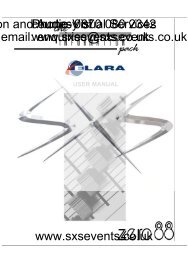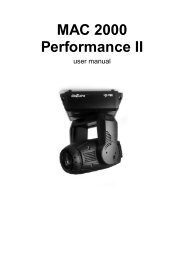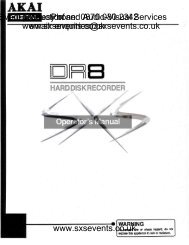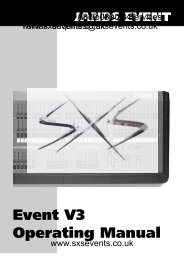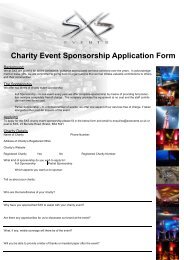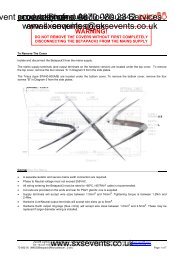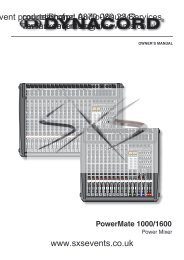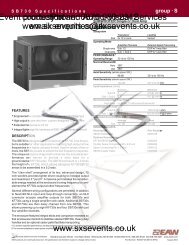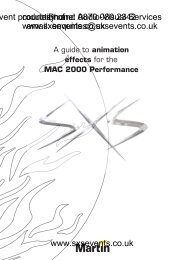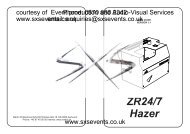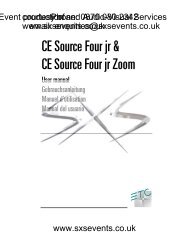Lighting - Martin mac600-manual - SXS Events
Lighting - Martin mac600-manual - SXS Events
Lighting - Martin mac600-manual - SXS Events
- No tags were found...
You also want an ePaper? Increase the reach of your titles
YUMPU automatically turns print PDFs into web optimized ePapers that Google loves.
ent production courtesy Phone: of and Audio-Visual 0870 080 2342 Serviceswww.sxsevents.co.ukemail: enquiries@sxsevents.co.ukMAC 600/Euser <strong>manual</strong>www.sxsevents.co.uk
ent production courtesy Phone: of and Audio-Visual 0870 080 2342 Serviceswww.sxsevents.co.ukemail: enquiries@sxsevents.co.uk© 1997 - 2000 <strong>Martin</strong> Professional A/S, Denmark.All rights reserved. No part of this <strong>manual</strong> may bereproduced, in any form or by any means, withoutpermission in writing from <strong>Martin</strong> Professional A/S,Denmark.Printed in Denmark.P/N 35000018 Rev. Gwww.sxsevents.co.uk
section 1ent INTRODUCTION production courtesy Phone: of and Audio-Visual 0870 080 2342 ServicesAbout this <strong>manual</strong> .................................................................................................................................................... 4Safety precautions ................................................................................................................................................... 4www.sxsevents.co.ukemail: enquiries@sxsevents.co.uksection 2SETUPUnpacking ................................................................................................................................................................ 5Installing or changing the lamp ................................................................................................................................ 5Powering the fixture ................................................................................................................................................. 5Rigging the fixture in place....................................................................................................................................... 6Connecting the serial link ......................................................................................................................................... 7Setting control protocol and address........................................................................................................................ 8Installing the snoot (optional) ................................................................................................................................... 8section 3OPERATION<strong>Martin</strong> RS-485 control .............................................................................................................................................. 9DMX-512 control ...................................................................................................................................................... 9Lamp ........................................................................................................................................................................ 9Mechanical effects ................................................................................................................................................. 10section 4CONTROL MODULEAddress and protocol selection.............................................................................................................................. 11Personality settings................................................................................................................................................ 12Readouts................................................................................................................................................................ 13Manual control........................................................................................................................................................ 13Test sequences...................................................................................................................................................... 14Utilities.................................................................................................................................................................... 14section 5MAINTENANCE ANDBASIC SERVICE OPERATIONSRemoving the printed circuit board ........................................................................................................................ 15Replacing the printed circuit board......................................................................................................................... 15Replacing fuses...................................................................................................................................................... 16Changing the XLR pin-out...................................................................................................................................... 16Changing lenses .................................................................................................................................................... 16Cleaning the optical path........................................................................................................................................ 16Cleaning the fans ................................................................................................................................................... 16Replacing the lamp ................................................................................................................................................ 17Optimizing lamp alignment..................................................................................................................................... 17Changing voltage and frequency settings.............................................................................................................. 17Updating software .................................................................................................................................................. 19section 6APPENDIXESDMX protocol ......................................................................................................................................................... 20Error messages...................................................................................................................................................... 22Troubleshooting .................................................................................................................................................... 23PCB layout ............................................................................................................................................................. 24Specifications......................................................................................................................................................... 25www.sxsevents.co.uk
section 1ent production courtesy Phone: of and Audio-Visual 0870 080 2342 ServicesINTRODUCTIONwww.sxsevents.co.ukemail: enquiries@sxsevents.co.ukThank you for selecting the MAC 600 from <strong>Martin</strong>. This intelligent moving-head Fresnel color changer is fast, quiet, and reliable.It delivers exceptionally bright light that instantly snaps or smoothly fades to virtually any color, at any intensity, anywhereon stage.About this <strong>manual</strong>This <strong>manual</strong> covers the MAC 600 with magnetic ballast and the MAC 600 Ewith electronic ballast. “MAC 600/E” is used torefer to both models when describing common features or procedures.This <strong>manual</strong> describes the features of software version 2.3. The latest MAC 600/E software and documentation are availablefrom the Service and Support area of the <strong>Martin</strong> web site at http://www.martin.dk.Safety precautionsThis product is for professional use only. It is not for household use.This product presents risks of lethal or severe injury due to fire and heat, electric shock, ultraviolet radiation, lamp explosion,and falls. before powering or installing the fixture, follow the safety precautions listed below and observeall warnings in this <strong>manual</strong> and printed on the fixture. If you have questions about how to operate the fixture safely, pleasecontact your <strong>Martin</strong> dealer or call the <strong>Martin</strong> 24-hour service hotline at +45 70 200 201.To protect yourself and others from electric shock• Disconnect the fixture from AC power before removing or installing the lamp, fuses, or any part, and when not in use.• Always ground (earth) the fixture electrically.• Use only a source of AC power that complies with local building and electrical codes and has both overload and groundfaultprotection.• Do not expose the fixture to rain or moisture.• Refer any service operation not described in this <strong>manual</strong> to a qualified technician.To protect yourself and others from UV radiation and lamp explosion• Never operate the fixture with missing or damaged lenses and/or covers.• When replacing the lamp, allow the fixture to cool for at least 15 minutes before opening the fixture or removing thelamp. Protect your hands and eyes with gloves and safety glasses.• Do not stare directly into the light. Never look at an exposed lamp while it is lit.• Replace the lamp before usage exceeds the maximum service life, or if the lamp is defective or worn out.To protect yourself and others from burns and fire• Never bypass the thermostatic switch or fuses. Always replace defective fuses with ones of the specified type and rating.• Keep all combustible materials (for example fabric, wood, paper) at least 1.0 meter (39 inches) away from the fixture.Keep flammable materials well away from the fixture.• Do not illuminate surfaces within 1.0 meter (39 inches) of the fixture.• Provide a minimum clearance of 0.1 meters (4 inches) around fans and air vents.• Never place filters or other materials over the lens.• Allow the fixture to cool for at least 5 minutes before handling.• Do not modify the fixture or install other than genuine <strong>Martin</strong> parts.• Do not operate the fixture if the ambient temperature (Ta) exceeds 40° C (104° F).To protect yourself and others from injury due to falls4• When suspending the fixture, verify that the structure can hold at least 10 times the weight of all installed devices.• Verify that all external covers and rigging hardware are securely fastened and use an approved means of secondaryattachment such as a safety cable.• Block access below the work area whenever installing or removing the fixture.• Do not lift the fixture by its head.www.sxsevents.co.uk
section 2ent production courtesy Phone: of and Audio-Visual 0870 080 2342 ServicesSETUPwww.sxsevents.co.ukemail: enquiries@sxsevents.co.ukThis section describes the simple steps required to prepare the MAC 600/E for operation.UnpackingThe MAC 600/Epackage includes:• 2 Fast-Lock Omega clamp brackets• 5-meter XLR-XLR control cable• Light snoot• User <strong>manual</strong>The packing material is carefully designed to protect the fixture during shipment - always use it or a custom MAC 500/600flight case to transport the fixture.Installing or changing the lampWARNING!Disconnect the fixture from AC power before proceeding. Always wear safety gogglesto protect your eyes and allow a hot lamp to cool for at least 15 minutesbefore removing it from the fixture.The MAC 600/E works with the Philips MSR-575/2 and MSD-575, and the Osram HSR-575/2. The lamp holder is pre-adjusted at the factory; precise alignment may be necessary due to slight variationsbetween lamps. The procedure is described on page 17.1. The MAC 600/E must be cool and isolated from AC power. Remove the 2 thumbscrews securing thelamp-socket assembly to the rear of the head. Pull out the lamp-socket assembly.2. If changing the lamp, remove the old lamp from the socket.3. Holding the new lamp by its ceramic base (do not touch the glass), insert it firmly and squarely into thelamp socket.4. Clean the glass bulb with the cloth supplied with the lamp, particularly if your fingers touch the glass. Aclean, lint-free cloth wetted with alcohol may also be used.5. Keep the lamp wire between the fins as you insert the lamp-socket assembly into the head. Turn theassembly counterclockwise to align the holes with the spacer nuts. Replace the thumbscrews andtighten them by hand.6. Before striking the lamp, reset the RLAH and RLST counters under the TIME menu to track lamp hoursand lamp strikes. See page 13.Powering the fixtureCheck voltage and frequency settingsThe settings must match the local AC power supply. These settings are printed on the serial number label on the base. If thesettings do not match the local conditions, then the ballast and/or transformer must be rewired. See section 5 for details.www.sxsevents.co.ukUser Manual 5
ent production courtesy Phone: of and Audio-Visual 0870 WARNING! 080 2342 Serviceswww.sxsevents.co.ukemail: enquiries@sxsevents.co.ukFor protection from dangerous electric shock, the fixture must be grounded(earthed). The AC mains supply shall be fitted with a fuse or circuit breaker andground-fault protection.Install a plug on the power cordYou may need to install a cord cap that fits your supply on the power cable. A 3-prong grounding-type plug must be installedfollowing the manufacturer’s instructions. Connect the wires to the pins as listed below. Note: The table shows some possiblepin identification schemes; if the pins are not clearly identified, or if you have any doubts about proper installation, consult aqualified electrician.Wire Color Pin Symbol Screw (US)brown live “L” yellow or brassblue neutral “N” silveryellow/green ground greenConnect the MAC 600/E directly to AC power. Toapply power, set the power switch on the base to the “I” position.Rigging the fixture in placeWARNING!Use 2 clamps to rig the fixture. Lock each clamp with both 1/4-turn fasteners. Thefasteners are locked only when turned fully clockwise.Attach an approved safety cable to the base.The MAC 600/E can be placed directly on the stage floor or rigged in any orientation on a truss. The integrated Fast-Lock systemenables quick and easy fastening of the clamp adapters in 4 different positions as shown below.safety wireattachment pointarrow points to front(neutral pan)1. Verify that the rigging clamps (not included) are undamaged and can bear at least 10 times the weightof the fixture. Bolt the clamps securely to the clamp brackets with a grade 8.8 (minimum) M12 bolt andlock nut, or as recommended by the clamp manufacturer.2. Tip the MAC 600/E on its side or install the clamps while the fixture is in the flight case.3. Align a clamp with 2 mounting points. Insert the fasteners into the base and turn both levers a full 1/4-turn clockwise to lock. Install the second clamp.4. Verify that the structure can bear at least 10 times the weight of all installed fixtures, clamps, cables,auxiliary equipment, etc.65. Working from a stable platform, hang the fixture on the truss. The front is indicated by an arrow on the base.www.sxsevents.co.uk6. Install a safety wire that can bear at least 10 times the weight of the fixture. The attachment point isdesigned to fit a caribiner clamp. Never use the carrying handles for secondary attachment.
7. Tighten the rigging clamps securely to the structure.ent production courtesy 8. Verify that Phone: there of are and no combustible Audio-Visual 0870 materials or 080 surfaces to be 2342illuminated Serviceswithin 1 meter of the fixture,and that there are no flammable materials nearby.www.sxsevents.co.ukemail: enquiries@sxsevents.co.ukConnecting the serial linkTips for building a serial link1. Use shielded twisted-pair cable designed for RS-485 devices. Standard microphone cable cannottransmit control data reliably over long runs; use only cable designed for RS-485 applications. 24 AWGcable is suitable for runs up to 300 meters (1000 ft). Heavier gauge cable and/or an amplifier is recommendedfor longer runs.2. Never use a “Y” connector to split the link. To split the serial link into branches use a splitter suchas the <strong>Martin</strong> 4-Channel Opto-Isolated RS-485 Splitter/Amplifier.3. Do not overload the link. Up to 32 devices may be connected on a serial link.4. Terminate the link by installing a termination plug in the output socket of the last fixture on the link.The termination plug, which is simply a male XLR connector with a 120 ohm, 0.25 watt resistor solderedbetween pins 2 and 3, “soaks up” the control signal so it does not reflect back down the link andcause interference. If a splitter is used, terminate each branch of the link.Connecting fixturesThe MAC 600/E has locking 3-pin data input and output sockets that can be configured for use with either DMX or <strong>Martin</strong>Protocol controllers. , i.e., pin 1 to shield, pin 2 to signal (-) andpin 3 to signal (+).3-pin to 3-pinPhase-ReversingCableConnectionsMale123Female1233-pin to 5-pinPhase-ReversingCableConnectionsMale123Female123455-pin to 3-pinPhase-ReversingCableConnectionsMale12345Female1235-pin to 3-pinStraightCableConnectionsMale12345Female1233-pin to 5-pinStraightCableConnectionsMale123Female12345P/N 11820006P/N 11820002P/N 11820003P/N 11820005P/N 118200041. Connect the controller’s data output to the MAC 600/E’s data input. For a• DMX controller with 5-pin output: use a cable with 5-pin male and 3-pin female connectors such asP/N 11820005. Pins 4 and 5 are not used.• DMX controller with 3-pin output: use a cable with 3-pin male and female connectors such as the onesupplied.• <strong>Martin</strong> RS-485 Protocol controller: use a phase-reversing cable, such as P/N 11820006, with 3-pinmale and female connectors or reconfigure the XLR output.2. Continue the link: connect the output of the fixture closest to the controller to the input of the next fixture.Use a phase-reversing cable when connecting a DMX-standard (pin 3 +) device to a <strong>Martin</strong>-standard(pin 3 -) device.3. Insert a male 120 Ω XLR termination plug in the output of the last fixture on the link.www.sxsevents.co.ukUser Manual 7
Setting control protocol and addressent production courtesy One of the operating modes Phone: shown of and below must be Audio-Visual 0870 selected. Factors to 080 consider when 2342selectingServicesa mode will depend on yourcontroller and are discussed in the next section. Maximum flexibility is provided in mode 4.www.sxsevents.co.ukemail: enquiries@sxsevents.co.ukEach fixture must be assigned its own channels to receive instructions from the controller. The address, also known as the startchannel, is the first channel used. Addresses are independent of the physical link: they may be set in any convenient order.Two MAC 600/E’s may share the same address; however, they will receive the same instructions and independent control willnot be possible.Mode <strong>Martin</strong> DMX 1 DMX 2 DMX 3 DMX 4Movement speed Vector Tracking Tracking and/or VectorPan/tilt resolution 16 bit 8 bit 16 bit 8 bit 16 bitChannels 2 10 12 12 141. Switch on the MAC 600/E.2. You may push [MENU] and [ENTER] simultaneously to disable pan and tilt reset. This is handy if youwant to change settings while the MAC 600/E is in a flight case. As the fixture does not run through theentire reset procedure, error messages will be displayed. This is not a fault with the fixture. The resetprocedure can take 2 - 3 minutes.3. Press the [MENU] key once, and then press the [↑] or [↓] keys repeatedly until the display showsPSET. Press [ENTER] to confirm.4. Press [↑] or [↓] until the desired protocol, as shown in the above table, appears on the display. Press[ENTER] to confirm.5. Press [↑] or [↓] repeatedly until the display shows either dAdr or MAdr, depending on whether youwish to select a DMX address or <strong>Martin</strong> address, respectively. Press [ENTER] to confirm.6. Press [↑] or [↓] repeatedly until the desired address is displayed. Press [ENTER] to confirm.Press [MENU] to return to the main menu. The address is displayed. Address and protocol settings are saved when thepower is switched off.Installing the snoot (optional)1. Bend the tabs 90°.2. Bend the ring into a circle with the tabs on the outside. Weave the end tab through the 3 slots.3. Insert the tabs between the 3 pairs of pins between the lens and the head cover.1 2 38www.sxsevents.co.uk
section 3ent production courtesy Phone: of and Audio-Visual 0870 080 2342 ServicesOPERATIONwww.sxsevents.co.ukemail: enquiries@sxsevents.co.ukThis section describes the MAC 600/E’s controllable features and the options for customizing them for your application.Option selection is described in the next section.<strong>Martin</strong> RS-485 controlThe MAC 600/E may be controlled with the <strong>Martin</strong> 3032 controller. For the fixture to respond, either the protocol setting(PSET) must be set to <strong>Martin</strong> (MART) as described in the previous section, or automatic protocol detection (SPEC/AUTO)must be enabled.DMX-512 controlTracking modeIn tracking mode the speed at which an effect moves is determined by the controller’s fade time. The effect tracks the fadefrom one DMX value to another and a digital filter algorithm ensures smooth movement at all fade speeds.There are 2 selectable tracking algorithms to provide extremely smooth movement with any controller. Algorithm 1 calculatesspeed based on the absolute value of DMX changes; it is recommended for use with most controllers. Algorithm 2 uses thereal value of DMX changes to calculate speed and may provide smoother movement if the controller-calculated DMX valuesare uneven.The number of samples, that is, changes in DMX values, used by both algorithms to calculate speed is selectable between alevel of 1 to 10. The ideal setting will vary from controller to controller - experiment for best results. Increasing the number ofsamples makes movement less responsive to sudden DMX changes and smoother as a result.Vector modeIn vector mode, 2 speed channels provide a way to control the effects’ speed with controllers that do not have programmablefade times. This mode may result in smoother movement when using a controller with a slow or irregular refresh rate. Vectormode also provides a “blackout” speed and overrides of the pan/tilt speed (PTSP), shortcut (SCUT), and studio mode (MOdE)menu settings.In vector mode the controller fade time should be set to 0, i.e., the position bumps from one value to the next. However, controllerfade times can be enabled by setting the speed channel between 0 and 2.8-bit versus 16-bit pan/tilt resolutionWith 8-bit pan/tilt resolution, the pan and tilt are divided into 256 equal increments. Finer position control and smoothermovement is provided in the 16-bit modes.LampThe MAC 600/E can be set to automatically strike within 90 seconds of being powered on by setting Automatic Lamp On(SPEC/ALON) to ON. A delay determined by the fixture address prevents all lamps from striking at the same time.If Automatic Lamp On is set to off, the default, the lamp remains off until a “lamp on” command is sent from the controller.Note: A peak of electric current that can be many times the operating current is drawn for an instant when striking the lamp.Striking many lamps at once may cause a voltage drop large enough to prevent lamps from striking or trip the main circuitbreaker. Avoid this by programming a “lamp on” sequence that strikes lamps one at a time at 5 second intervals.Power to the lamp can be turned off from the controller if the DMX Lamp Off (SPEC/dLOF) feature is enabled. There is acombination of DMX values that allows you to turn off the lamp even if this feature is disabled. : it is not possible tostrike the lamp within 8 minutes of having switched it off. The MAC 600/E will store a “lamp on” command and strike thelamp automatically when the 8 minutes have elapsed.With the MAC 600 E, lamp power falls to 400 watts for cooler operation and longer lamp life when the shutter is closed for 10seconds. Power instantly returns to full when the shutter opens. Reduced-power mode with the shutter open can be forced bysetting channel 1 to a DMX value from 116 to 122.www.sxsevents.co.ukUser Manual 9
Mechanical effectsent production courtesy Phone: of and Audio-Visual 0870 080 2342 Serviceswww.sxsevents.co.ukemail: enquiries@sxsevents.co.ukAll mechanical effects are reset to a “home” position when the fixture is powered up. The fixture can also be reset via DMX ifDMX reset (SPEC/dRES) is enabled. There is also a combination of DMX values that allows you to reset the MAC 600/Eeven if this feature is disabled; see the DMX protocol for details.An on-the-fly position correction system automatically corrects the position of the effect wheels. This feature can be disabledby setting effects feedback (SPEC/EFFb) to OFF.General operation may be optimized for speed or quietness with the studio mode setting (MOdE).Pan and tiltThe moving head can be panned 440° and tilted 306°. The middle of the pan range is perpendicular to the front of the fixture,as indicated by the arrow on the base. Movement may be optimized for speed by setting the pan/tilt speed (PTSP) personalityto FAST, or for smoothness by setting it to NORM. The setting may be overridden on the speed channel in vector mode.Movement is disabled if lamp feedback is lost - indicating a blown lamp - to prevent possible damage or injury due to glassfragments.Setting the movement speed to “blackout” in vector mode causes the shutter to black out the light while the head is moving.The pan and tilt DMX channels can be inverted and/or swapped for convenience using the pan/tilt (PATI) menu.Color wheelThe color wheel has red, green, and blue dichroic color filters plus a 5600K to 3400K color correction filter and open white.The wheel can be scrolled, allowing for split color effects, snapped to fixed positions, and continuously rotated in both directionsat different speeds.The Shortcuts (SPEC/SCUT) setting determines whether the wheel takes the shortest path to the next position or turns in onedirection only. The setting may be overridden on the speed channel in vector mode.Setting the color speed to “blackout” in vector mode causes the shutter to black out the light while the wheel moves.CMY subtractive color mixingThe CMY color mixing system is based on three graduated dichroic color filters: cyan, magenta, and yellow. Each color canbe added from 0 to 100%. A very wide range of colors may be achieved by varying the amount of each color. Since the CMYsystem is subtractive, mixing 3 colors together results in a loss of light. For maximum brightness, mix 2 colors at a time. Threespeed random CMY color mixing is available at the top of channel 6.The Shortcuts (SPEC/SCUT) setting determines whether the wheels take the shortest path to the next position or turn in onedirection only. The setting may be overridden on the speed channel in vector mode.Beam shapers and frostTwo beam shapers allow you to widen and flatten the beam. Beam shaper 1 rotates 180° and beam shaper 2 rotates 90°. Theymay be combined to drag the beam horizontally and vertically to increase the beam size.A frost filter on the same wheel as beam shaper 2 softens the beam.DimmerThe mechanical dimmer provides smooth, high-resolution 100 percent dimming.ShutterThe high-speed mechanical shutter opens and closes the light instantly. Light can be flashed at up to 8 Hz and there is a DMXcallablerandom strobe function.10If the auto shutter function (SPEC/ASHT) is enabled, the shutter, which is faster than the dimmer, automatically closes whenthe dimmer receives a command to close “instantly,” to provide faster blackouts.www.sxsevents.co.uk
section 4ent production CONTROL courtesy Phone: MODULE of and Audio-Visual 0870 080 2342 Serviceswww.sxsevents.co.ukemail: enquiries@sxsevents.co.ukThe 4-digit LED control panel on the side of the MAC 600/E allows you to set the address and personalities, read lamp hoursand other information, calibrate effects, control the fixture <strong>manual</strong>ly, and run a test routine. Most of these functions may beperformed remotely via the serial link with a <strong>Martin</strong> MPBB1 or MP-2 uploaderThe display can be flipped for easy reading by pressing the [↑] and [↓]keys simultaneously. The intensity is adjustable and thedisplay can be set to go out 2 minutes after the last key-press.The DMX or <strong>Martin</strong> address, depending on the protocol setting, and any error messages are displayed when the MAC 600/E isturned on. To enter the menu, press [MENU]. Use the [↑] and [↓]keys to move within the menu. To select a function or submenu,press[ENTER]. To escape a function or menu, press [MENU].Address/MessagesPSET dAdr MAdr TIME AdJ CAL PATI MAN dMXL TSEQ PTSP EFSP MOdE VER SPECPo HRPoHLA HRLAHLSTRRLSTRSTL ONLoFFHEAdALLdIMCYANMAGYELCOLBS1BS2SHUTPATIP OFT OFd OFC OFM OFY OFSWAPPINVTINVRSTL ONLoFFSHUTdIMCYANMAGYELCOLBS1BS2PANTILTSTCOCH 0....CH13CPUFEbAdISPdISPdINTdLoFdRESALONFEbAdFSEFACTCUS1CUS2CUS3dFOFAUTOUPLdASHTTEMPbASEHEAdFANPCbTSCUTFTSTEFFbTRACMOdECALETYPAddress and protocol selectionPSET Switch between MART, DMX1, DMX2, DMX3,or DMX4 to enable <strong>Martin</strong> mode or DMX mode1, 2, 3, or 4.dAdr Set the DMX address between channel 1 and 512.<strong>Martin</strong> address (MAdr): Set the <strong>Martin</strong> address between channel 1 and 31.www.sxsevents.co.ukUser Manual 11
Personality settingsent production courtesy Phone: of and Audio-Visual 0870 080 2342 ServicesPersonality Path Options Effect (Default settings shaded.)FAST Optimize movement for speed.*Pan/tiltwww.sxsevents.co.ukspeed PTSPNORM Optimize movement for smoothness.*Pan/tilt swapPan inverseTilt inverseTracking algorithmPATI/SWAPPATI/PINVPATI/TINVSPEC/TRAC/MOdEONOFFONOFFONOFFMOd1MOd2Map DMX pan control to tilt channel and vice versa.Normal pan and tilt control.Reverse DMX pan control, right left.Normal pan control, left right.Reverse DMX tilt control, down up.Normal tilt control, up downAbsolute delta value algorithm (for most controllers)Real delta value algorithmTracking samples SPEC/TRAC/CAL 1-10 Tracking samples. Increase if pan/tilt is not smooth.Effects speedDisplay on/offEFSPSPEC/dISPFASTSAFEONOFFNormal, full speed operation.Reduced speed operation (mainly for early models).Display stays on.Display intensity SPEC/dINT 10-100 Adjust display intensity.DMX lamp offDMX resetAutomatic lamp onAutomatic protocoldetectionShortcutsAutomatic shutterStudio modePan/tilt feedbackEffects feedbackFan speedElectronic ballasttypeemail: enquiries@sxsevents.co.ukSPEC/dLOFSPEC/dRESSPEC/ALONSPEC/AUTOSPEC/SCUTSPEC/ASHTMOdESPEC/FEbASPEC/EFFbSPEC/FANSPEC/ETYPONOFFONOFFONOFFONOFFONOFFONOFFNORMSTUdONOFFONOFFREGFULLSCHIMITRDisplay goes out 2 minutes after last key press.Enable DMX lamp off command.Disable DMX lamp off command.*Enable DMX reset command.Disable DMX reset command.*Lamp strikes automatically within 90 seconds of power on.Strike lamp from controller.Enable automatic protocol detection.Disable automatic protocol detection.Effect wheels turn the shortest direction.*Effect wheels always turn same direction.*Shutter “helps” dimmer black out.Shutter not affected by dimmer commands.Optimize effects for speed.*Optimize effects for silence.*Enable pan/tilt position correction system.Disable pan/tilt feedback. Setting not saved.Enable feedback on effect wheels.Disable feedback on effect wheels.Enable automatic fan speed regulation.Set fan speed to full.Select Schiederwerk ballast (MAC 600 E's after S/N4020700000)Select Mitronic ballast (MAC 600 E’s with date-based S/N orbefore S/N 4020700000)* Setting may be overridden via DMX. See the protocol for details.12www.sxsevents.co.uk
Readoutsent production courtesy Phone: of and Audio-Visual 0870 080 2342 ServicesUsage readouts (TIME)www.sxsevents.co.ukemail: enquiries@sxsevents.co.ukRead the total number of power-on hours (Po H), power-on hours since last reset (RPoH), total lamp hours (LA H), lamphours since last reset (RLAH), total number of lamp strikes (LSTR), and the number of lamp strikes since last reset (RLST).The resettable counters may be used to track overall usage and lamp life. To reset to zero, display the readout and then press[↑] for 5 seconds.DMX value readouts (dMXL)Read the DMX start code (STCO) and DMX values received for each channel. This is an easy way to check that the start codeis 0 and that the fixture is receiving the expected commands.If the fixture is set to a DMX mode where some or all of the channels between 10 and 13 are not used, the readout on thesechannels will be N/A. Note: the channel number is 1 less in the readout than it is in the DMX protocol.Software version readouts (VER)Read the version number of the CPU software (CPU), pan/tilt feedback circuit (FEbA), and display module software(dISP). The CPU software version is also displayed for a moment at power up.Temperature readouts (SPEC/ TEMP)Read temperature in the base (bASE) and head (HEAd) in Celsius. Temperatures below 25° C are shown as -25; temperaturesabove 100° C are shown as +100.Thetemperature sensors are calibrated at the factory and adjustment should not be necessary. The following procedure calibratesthe sensors if they give no or faulty readings.1. Allow the unit to cool to room temperature (powered off for at least 4 hours).2. Measure the room temperature in Celsius. (To convert F° to C°, subtract 32° and then multiply by0.555.)3. Power up the unit and allow it to reset.4. Press the [MENU] and [↓] keys at the same time and hold them for 3 seconds until “25” shows in thedisplay.5. Press the [↑] and [↓] keys until the display shows the temperature measured.6. Press [ENTER] to save the setting.Manual controlManual control (MAN)The <strong>manual</strong> control menu permits you to do the following without a controller:• reset the fixture (RST)• turn the lamp on and off (L ON, LoFF)• open, close, and strobe the shutter at 3 speeds (SHUT)• control the dimmer (dIM)• control the CMY wheels (CYAN, YEL, MAG)• move the color wheel to each position (COL)• control both beam shapers (BS1, BS2)www.sxsevents.co.uk• control pan and tilt (PAN, TILT)User Manual 13
Adjustment (AdJ)ent production courtesy The adjustment menu provides Phone: of <strong>manual</strong> and control for Audio-Visual 0870 making mechanical 080 adjustments. 2342These should Servicesonly be performed by aqualified technician. The menu provides functions to reset the fixture (RST), turn on and off the lamp (L ON, LoFF), controlall effects in the head (HEAd), and move the head to the home and extreme positions (PATI). The HEAd submenuwww.sxsevents.co.ukemail: enquiries@sxsevents.co.ukcontains functions to:• move ALL effects to the OPEN, SPOS (sensor position), and APOS (adjustment position - requires special tool).• move each effect individually to the open, sensor, and adjustment positions. The shutter has a closed position instead ofa sensor position.Test sequencesUtilitiesTest sequence (TSEQ)Run a general test of all effects.Printed circuit board test (SPEC/PCBT)3 tests of the circuit board for service use.Factory test (SPEC/FTST)An effects test (WTST), a movement test (MTST), and a sensor test (STST) used for factory quality control. The sensortest includes programs for testing sensors on the effect wheels.Calibration (CAL)The calibration menu allows you to adjust the effects to achieve total uniformity between fixtures: it is not a substitute formechanical adjustment. Pan (P OF), tilt (T OF), dimmer (d OF), cyan (C OF), magenta (M OF), and yellow (Y OF)may be selected and adjusted from 1 to 255 with the arrow keys. Press [ENTER] to save the calibration.Reset default offsets (SPEC/dFOF)Reset all calibrations to their factory defaults. Select dFOF and press [ENTER] when SURE is displayed, or press [MENU]to escape.Reset default personality settings (SPEC/ dFSE/ FACT)Return all personality settings (not calibrations) to their factory defaults. Select FACT and press [ENTER] when LOAD isdisplayed.Custom configurations (SPEC/ dFSE/ CUS1, CUS2, CUS3)Save and load 3 sets of custom configurations. To save a custom configuration, adjust the settings as desired, go to CUS1,CUS2, or CUS3 and press [ENTER] when SAVE is displayed. To load a custom setting, select it and press [ENTER]when LOAD is displayed.Upload mode (UPLd)Upload mode prepares the MAC 600/E to receive control software. It is normally engaged automatically by the upload device.In certain circumstances, however, you may have to set upload mode <strong>manual</strong>ly as described under “Updating software” onpage 19.14www.sxsevents.co.uk
section 5ent production MAINTENANCE courtesy Phone: of and AND Audio-Visual 0870 080 2342 ServicesBASIC www.sxsevents.co.ukemail: SERVICE enquiries@sxsevents.co.ukOPERATIONSThe MAC 600/E requires regular maintenance to keep performing at its optimum. The maintenance schedule will be dependentupon the operating environment. Dirty lenses and filters reduce the light’s brightness. Cooling fans covered by dust maycause overheating, thus causing the thermostat to cut out the lamp intermittently. This section takes you through the generalmaintenance procedures and describes some basic service operations.WARNING!All service procedures that require removing covers shall be performedby a qualified technician.Disconnect from AC power before removing any cover or part.Removing the printed circuit board1. Disconnect the fixture from AC power.2. Remove the flat plate from the top of the front side of the base. Do not remove the curved side plates.3. Unplug the white plastic wire connectors from the top of the printed circuit board. To unplug a connector,hold the plastic connector - never pull the wires - and pull it straight off the pins.4. Grasp the black pins on either end of the circuit board and gently pull it out. You may have to guidesome wires past the motor housing. Be careful not to knock the copper heat sinks.Replacing the printed circuit board1. Gently put the circuit board back into the base. You may have to guidesome wires past the motor housing. Push the black pins down to lock theboard in place.2. Reconnect the wire connectors. Each connector (except for the 2 fanconnectors and the control module connector) is labelled. Fit the femaleover the male with the “rails” on the female connector over the “tongue”on the male connector. Your MAC 600/E may or may not have unusedconnectors PL301 and PL302. Starting from the end with the copper heat sinks, the connection orderis:PL201 displayPL202 OPTO1PL203 OPTO2PL302 not usedPL303 4-pin fanPL304 2-pin fanPL301 not usedPL401 DIMPL411 CYANPL421 MAGPL431 YELLPL441 COLORPL501 BEAM1PL511 BEAM2PL521 SHUTPL531 PANPL551 TILT3. Replace the top cover.www.sxsevents.co.ukUser Manual 15
Replacing fusesent production courtesy The main fuse is locatedPhone: above the of and XLR output and Audio-Visual 0870 is replaced by unscrewing 080 the holder 2342with a screwdriver Servicesor small coin. Thesecondary fuses are located on the printed circuit board and are replaced as follows.www.sxsevents.co.uk1. email: Remove the printed enquiries@sxsevents.co.ukcircuit board as described above.2. Locate and replace the defective fuse with one of the same rating. The fuses are shown on the PCBlayout diagram on page 24 as F601, F602, and F603. Their values are listed on page 25.3. Replace the printed circuit board.Changing the XLR pin-out1. Remove the printed circuit board asdescribed above.2-2-2. Position the jumpers for the desiredXLR pin-out as shown.+3+33. Replace the printed circuit board.<strong>Martin</strong> pin-outDMX pin-outChanging lensesWARNINGAttach the safety wire to the front head section.18° and 65° field angle options are available for the MAC 600/E. (See “Accessories” on page 26.) The lens is mounted on asnap-lock “lens hood” or front section that attaches easily to the head. Simply release the snap locks and unhook the safetywire to remove the standard lens front. Hook the safety wire to the same location on the optional front and snap the locksclosed.IMPORTANTThe long front (18° option) does not fit in some flight cases.The 18° front is longer than the standard front; the MAC 600/E fitted with this option fits only in flight cases produced afterSeptember, 1997. These can be identified by the outside measurements: 894 mm (35.2") from bottom to top, including wheels.Older flight cases measure 860 mm (34") from bottom to top, including wheels, on the outside.Verify that the flight case is of the newer type before shipping MAC 600/Es fitted with the 18° long front.Cleaning the optical pathCleaning and servicing components in the head is best left to qualified <strong>Martin</strong> technicians.To access the optical components, remove the head cover. Remember to attach the internal safety cable when reassembling thehead.Be very careful if you decide to clean the optical components. The colored surface on the dichroic filters is achieved by meansof special multi-layer coatings and even small scratches in these might be visible. Residues left from cleaning fluids can bakeonto and ruin the component.Wash dirty lenses and filters with isopropyl alcohol. Rinse with distilled water: mixing the water with a small amount of wettingagent such as Kodak Photoflo will help prevent streaking and spotting. Dry with a clean, soft and lint-free cloth or blowdry with compressed air. A generous amount of regular window glass cleaner may also be used, but no residues may remain.Cleaning the fansTo ensure proper cooling of the fixture it is important that the fans are free of dust. Clean the fans with a vacuum or damp clothif they are dirty.16www.sxsevents.co.uk
Replacing the lampent production courtesy Phone: of and Audio-Visual 0870 080 2342 Serviceswww.sxsevents.co.ukemail: enquiries@sxsevents.co.ukThe risk of lamp explosion increases with lamp hours as the quartz envelope gradually weakens. It is recommended that lampusage not exceed 125 percent of the lamp’s rated average life.The procedure for installing the lamp is described on page 5. After installing the lamp, reset the RLAH and RLST countersunder the TIME menu as described page 13.Optimizing lamp alignmentThe lamp alignment is set at the factory. If, however, the distribution of light does not appear even, lamp alignment can beadjusted.1. Switch on the MAC 600/E and allow it to reset.2. Using either a controller or the control module, turn on the lamp and aim the light towards a flat surface.3. Center the hot-spot (the brightest part of the beam) using the 3 allen-head (3 mm) adjustment screws.Turn one screw at a time to drag the hot-spot diagonally across the projected image. If you cannotdetect a hot-spot, adjust the lamp until the light is even.4. To reduce a hot-spot, pull the lamp in by turning all three screws clockwise 1/4-turn at a time until thelight is evenly distributed.5. If the light is brighter around the edge than it is in the center, or if light output is low, the lamp is too farback in the reflector. “Push” the lamp out by turning the screws counterclockwise 1/4-turn at a timeuntil the light is bright and evenly distributed.Changing voltage and frequency settings These settings are printed on the serial numberlabel on the bottom of the base. Using the wrong setting can cause overheating, fixture damage, and/or poor performance.MAC 600 (magnetic ballast)1. Disconnect the MAC 600 from AC power. Remove the top covers.2. Find the correct transformer and ballast terminals for your AC supply in the table below. Consult aqualified electrician if you do not know the AC frequency and voltage.AC Supply Transformer Magnetic BallastFrequency Voltage Voltage Terminal Setting Terminal50 Hz 200-210 V 210 V 4 200 V / 50 Hz 750 Hz 210-220 V 210 V 4 230 V / 50 Hz 1050 Hz 220-235 V 230 V 6 230 V / 50 Hz 1050 Hz 235-240 V 230 V 6 245 V / 50 Hz 1250 Hz 240-260 V 250 V 8 245 V / 50 Hz 1260 HZ 200-217 V 210 V 4 208 V / 60 Hz 460 HZ 217-240 V 230 V 6 227 V / 60 Hz 73. Locate the transformer: it is on the left end, near the power switch. Move the BROWN and RED transformerwires to the correct terminal. The terminal number is printed in front of the connection tab.4. Locate the magnetic ballast: it is on the opposite end from the transformer, near the control panel.Move the BROWN ballast wire to the correct terminal. The terminal number is printed in front of theconnection tab.www.sxsevents.co.uk5. Replace the top covers before applying power.User Manual 17
MAC 600 E (electronic ballast)ent production courtesy The electronic works Phone: at of any and voltage between Audio-Visual 0870 100 and 250 volts, 080 and at any frequency 2342 between Services50 and 60 Hz.1. Disconnect the fixture from AC power. Remove the top covers.www.sxsevents.co.ukemail: enquiries@sxsevents.co.uk2. Tap the transformer for the local supply voltage as shown below.3. Verify that the primary fuse, which is located near the power switch, is correct for the voltage setting.Use a T 6.3 A fuse when the transformer is set at 200, 210, 220, 230, or 240 V. Use a T 10 A fusewhen it is set at 100, 110, or 120 V.4. Replace the top covers before applying power.blackblackblackbrownred7 8 967 8 967 8 967 8 96blue54100 Vbrownred54110 Vbrownred54120 Vblack54200 Vbrownred3blue3blue33blueblue1blueblue1blueblue1blueblue1brownredbrownredbrownredbrownredblack7 8 9654 210 Vblack7 8 9654 220 Vblack7 8 9654 230 Vblack7 8 9654 240 V3333blueblue1blueblue1blueblue1blueblue1MAC 600 E Transformer Settings18www.sxsevents.co.uk
Updating softwareent production courtesy Phone: of and Audio-Visual 0870 080 2342 ServicesThe latest MAC 600/E software is available from your <strong>Martin</strong> dealer and the <strong>Martin</strong> Professional web site. Be sure to read theupgrade notes included with the software.www.sxsevents.co.ukemail: enquiries@sxsevents.co.ukSoftware updates are installed using a <strong>Martin</strong> MPBB1, MP-2, or a LightJockey 4064 DMX interface card. The procedure isfound in the upload device’s user <strong>manual</strong> and, when using the 4064 card, the <strong>Martin</strong> Software Uploader program’s online helpfile.Normal uploadThe uploader is connected to the fixture just like a controller. Under normal conditions, software can be installed from aremote location - there is no need to set the MAC 600/E to boot mode. Please refer to the uploader <strong>manual</strong> for instructions.Boot mode uploadIf the data is corrupted during transmission a check-sum error (CSER) will occur and after 15 seconds the fixture will automaticallyswitch over to boot mode (UPLd) and be ready for a boot mode upload.If a software upload to the MAC 600/E is interrupted, the fixture must be powered off for at least 10 seconds before a newupload can be attempted. When powered on, a check-sum error will occur and it will automatically go into boot mode, readyfor a second upload attempt. Select boot mode upload on the upload device.If there is no functional software in the MAC 600/E memory, the fixture must be set to boot mode <strong>manual</strong>ly before starting theupload. If the control panel works, select UPLd from the SPEC menu and confirm when SURE is displayed by pressing[ENTER].If the control panel does not work, boot mode can be engaged by movingjumper PL121 on the main circuit board to pins 1 and 2 as follows.PL121INITPL121INIT1. Remove the printed circuit board as described above. Itmay not be necessary to unplug the connectors.2. Position jumper PL121 to boot mode (INIT) as shownabove. See also the circuit board layout diagram onpage 24.3. Plug in any unplugged connectors, apply power to the MAC 600/E, and proceed with the upload.4. After the upload, disconnect the fixture from the electricity, move the jumper back to the normal setting,and replace the circuit board.1boot setting1normal settingwww.sxsevents.co.ukUser Manual 19
appendix aent DMX production courtesy PROTOCOL Phone: of and Audio-Visual 0870 080 2342 Serviceswww.sxsevents.co.ukemail: enquiries@sxsevents.co.ukDMX channel Start code = 0DMX1 DMX2 DMX3 DMX4 Value Percent Function1Note:Lamp Off is allowed with SPEC/dLoFset to ON, or with SPEC/dLoF set toOFF and cyan, magenta and yellowset between 230 and 232.Reset is allowed with SPEC/dRESset to ON, or with SPEC/dRES set toOFF and cyan, magenta and yellowset between 230 and 232.23450 - 1920 - 4950 - 112113 - 115116 - 122123 - 127128 - 147148 - 167168 - 187188 - 207208 - 217218 - 227228 - 237238 - 247248 - 2550 - 78 - 1920 - 4444 - 4545 - 4848 - 5050 - 5858 - 6566 - 7374 - 8182 - 8585 - 8989 - 9393 - 9797 - 1000 - 255 0 - 1000-255 0 - 1000-255 0 - 1000-255 0 - 1000 - 4040 - 8080 - 120120 - 1600 - 1616 - 3131 - 4747 - 63Shutter closedShutter openStrobe on (fast->slow)Shutter closedShutter open, reduced lamp power (MAC 600 E)Shutter closedRandom Strobe FastRandom Strobe MediumRandom Strobe SlowShutter closedReset FixtureShutter closedLamp power onShutter closedLamp power off : T ≥ 5 seconds0 100%White CyanWhite MagentaWhite YellowScrollWhite Color 1Color 1 Color 2Color 2 Color 3Color 3 Color 46161 - 165166 - 170171 - 175176 - 180181 - 18563 - 6565 - 6767 - 6969 - 7171 - 73Fixed ColorsColor 4Color 3Color 2Color 1White186 - 214215 - 24373 - 8484 - 95Continuous RotationCW, fast slowCCW, slow fast20244 - 247248 - 251252 - 2557 01 - 255890 - 23 - 170171 - 25596 - 9797 - 9899 - 10000 - 1000 - 11 - 6767 - 1000 - 255 0 - 100Random CMY ColorRandom color, fastRandom color, mediumRandom color, slowOpenBeam shaper left rightOpenBeam shaper left rightFrostLeft right (128 = neutral)Left right- 10 - 100 - 255 0 - 100www.sxsevents.co.uk
ent production courtesy Phone: of and Audio-Visual 0870 080 2342 Servicesemail: enquiries@sxsevents.co.ukDMX channel Start code = 0DMX1 DMX2 DMX3 DMX4 Value Percent Functionwww.sxsevents.co.uk10 11 10 110 - 255 0 - 100 Up down (128 = neutral)- 12 - 120 - 255 0 - 100 Up down- - 11 13- - 12 140 - 23 - 245246 - 248249 - 251252 - 2550 - 23 - 239240 - 242243 - 245246 - 248249 - 251252 - 2550 - 23 - 239240 - 242243 - 245246 - 248249 - 251252 - 2550 - 11 - 9696 - 9798 - 9899 - 1000 - 11 - 9494 - 9595 - 9696 - 9798 - 9899 - 1000 - 11 - 9494 - 9595 - 9696 - 9798 - 9899 - 100TrackingFast slowTracking, normal speed (override PTSP FAST)Tracking, fast speed (override PTSP NORM)BlackoutTrackingFast slowTracking, MOdE = NORM (studio mode off)Tracking, MOdE = STUd (studio mode on)Tracking, SCUT = OFF (shortcuts off)Tracking, SCUT = ON (shortcuts on)FastSpeed: Color, Beam Shaper 2TrackingFast slowTracking, MOdE = NORM (studio mode off)Tracking, MOdE = STUd (studio mode on)Tracking, SCUT = OFF (shortcuts off)Tracking, SCUT = ON (shortcuts on)Blackoutwww.sxsevents.co.ukUser Manual 21
appendix bent ERROR production courtesy MESSAGES Phone: of and Audio-Visual 0870 080 2342 Serviceswww.sxsevents.co.ukemail: enquiries@sxsevents.co.ukDisplay readout Appears if... What to doAUTO (Automatic protocol detectionerror)LERR (Lamp error)... automatic protocol detection isenabled but the protocol (<strong>Martin</strong>/DMX)cannot be determined because there isno control data..... the lamp doesn’t ignite within 10 minutesof receiving the ‘Lamp ON’ command.Likely reasons are a missing ordefective lamp, or insufficient AC voltage.• Verify that the controller issending and the serial link isproperly connected.• Check the lamp and check thatthe mains setting of the fixturematches the mains supply.MERR (Memory error) ...the EEPROM memory cannot be read. • Contact <strong>Martin</strong> service personnelfor assistance.CSER (Check-sum error) ...a software upload is not successful • Upload software again, seepage 19.****ShER (Short error)HoT (Hot lamp)bTER (Base temperature error)HTER (Head temperature error)FbEP (Feedback error pan)FbET (Feedback error tilt)FbER (Feedback error pan/tilt)PAER (Pan time-out)TIER (Tilt time-out)... there is no communication betweenthe control module and motherboard.This readout appears briefly whenswitching on the fixture.... the fixture detects that the lamp is ONbut no ‘Lamp ON’ command has beenreceived. This can occur if the lamprelays are stuck in the ON position or ifthe lamp-power feedback circuit hasfailed. You can still operate the fixture butmay not be able to remotely switch offthe lamp.... you attempt to strike the lamp within 8minutes after having switched it off. Thefixture will store the ‘Lamp ON’ instructionand strike the lamp once the 8 minuteshave elapsed....there is a malfunction in the base orhead temperature sensing circuit....pan (FbEp), tilt (FbET) or both (FbER)feedback circuits are malfunctioning. Itwill still be possible to operate the fixture,though it goes into a “safe” mode wheremaximum speed is reduced, thus preventingthe fixture from losing track of itshome position (losing step)....pan and/or tilt indexing circuit is malfunctioning.The fixture will, after thetime-out, establish a mechanical stop,and continue to work normally.• Check fuses on motherboardand replace accordingly.• Check that ribbon cablebetween control module andmotherboard is connectedproperly.• Contact <strong>Martin</strong> service personnelfor assistance.• Wait until the lamp strikes.• Contact <strong>Martin</strong> service personnelfor assistance.• Contact <strong>Martin</strong> service personnelfor assistance.• Contact <strong>Martin</strong> service personnelfor assistance.DIER (Dimmer time-out)CYER (Cyan time-out)MAER (Magenta time-out)YEER (Yellow time-out)COER (Color time-out)b1ER (Beam shaper 1 time-out)b2ER (Beam shaper 2 time-out)22...the magnetic-indexing circuit is malfunctioning(e.g. sensor defective ormagnet missing). After the time-out, theeffect in question will stop in a randomposition.www.sxsevents.co.uk• Contact <strong>Martin</strong> service personnelfor assistance.
appendix cent production TROUBLESHOOTINGcourtesy Phone: of and Audio-Visual 0870 080 2342 Serviceswww.sxsevents.co.ukemail: enquiries@sxsevents.co.ukProblem Probable cause(s) RemedyOne or more of the fixtures iscompletely dead.Fixtures reset correctly but allrespond erratically or not at all tothe controller.Fixtures reset correctly but somerespond erratically or not at all tothe controller.No light and “LERR” error messagedisplayed.Lamp cuts out intermittently.Low light outputFixture not powered on.Primary fuse blown (located at themains inlet cable).Secondary fuse(s) blown (locatedon PCB inside the fixture base).The controller is disconnected fromthe data link.XLR pin-out of the controller doesnot match pin-out of the first fixtureon the link (i.e. signal is reversed).Bad data link connection.Data link not terminated with 120Ωtermination plug.Incorrect addressing of the fixtures.One of the fixtures is defective anddisturbs data transmission on thelink.XLR pin-out on fixtures does notmatch (pins 2 and 3 reversed).The ballast and transformer settingsdo not match local AC voltage andfrequency.Lamp blown.Lamp not installed.Fixture is too hot.The ballast and transformer settingsdo not match local AC voltage andfrequency.Lamp near end of life.The ballast and transformer settingsdo not match local AC voltage andfrequency.(MAC 600 E) Incorrect ballast typeselected.Misaligned lamp.Check that power is switched on and cablesare plugged in.Disconnect fixture and replace fuse.Disconnect fixture. Check fuses on PCB(F601 and F602) and replace.Connect controller.Install a phase-reversing cable between thecontroller and the first fixture on the link.Inspect connections and cables. Correct poorconnections. Repair or replace damagedcables.Insert termination plug in output jack of thelast fixture on the link.Check fixture address and protocol settings.(page 8)Bypass one fixture at a time until normal operationis regained. Do this by unplugging theXLR in and out connectors and connectingthem directly together. Have the fixture servicedby a qualified technician.Install a phase-reversing cable between thefixtures or swap pins 2 and 3 in the fixture thatbehaves erratically.Disconnect fixture. Check ballast and transformersettings and correct if necessary.Disconnect fixture and replace lamp.Disconnect fixture and install lamp.Allow fixture to cool.Reduce ambient room temperature.Set fan speed to full.Recalibrate temperature sensors.Disconnect fixture. Check ballast and transformersettings and correct if necessary.Replace lamp.Disconnect fixture. Check ballast and transformersettings and correct if necessary.Check S/N and set ballast type personalityaccordingly.Adjust lamp.www.sxsevents.co.ukUser Manual 23
appendix dent PCB production courtesy LAYOUT Phone: of and Audio-Visual 0870 080 2342 Serviceswww.sxsevents.co.ukemail: enquiries@sxsevents.co.ukMAINS INMAINS OUT (TO BALLAST IN)LAMP FEEDBACKCONTROL MODULETILT FEEDBACKPAN FEEDBACKMAGNETIC SENSORSPAN/TILT INDEX SWITCESFAN (HEAD) + TEMP SENSORFAN (BASE)DIMMERCYANDATA LINKJUMPER FOR XLR PIN-OUTMAGENTAYELLOWCOLORBEAM 1BEAM 2SHUTTERAC INPANTILT24www.sxsevents.co.uk
appendix eent productionSPECIFICATIONScourtesy Phone: of and Audio-Visual 0870 080 2342 Serviceswww.sxsevents.co.ukemail: enquiries@sxsevents.co.uk45640325°145437579420356481dimensions in millimetersMeasurements• Dimensions (LxWxH) without clamps .................................... 481 x 456 x 610 mm (18.9 x 17.9 x 24 in)• Minimum rigging distance, center to center................................................................... 457 mm (18 in)• Weight, without clamps, MAC 600 .............................................................................. 31.5 kg (69.3 lb)• Weight, without clamps, MAC 600 E ........................................................................... 25.4 kg (55.9 lb)Electrical, magnetic ballast version• Ballast taps ............................................................................ 200/230/245 V, 50 Hz; 208/27 V, 60 Hz• Power and current............................................. 750W, 3.9A @ 230V/50Hz; 750W, 4.2A @ 208V/60Hz• Power factor (PF)......................................................................................................................... 0.85Electrical, electronic ballast version• Transformer taps....................................................... 100/110/120/200/210/220/230/240 @ 50 - 60 Hz• Power and current................................................................................. 690 W, 3.2 A @ 230 V / 50 Hz• Power factor (PF)......................................................................................................................... 0.94Fuses• Primary fuse, MAC 600, MAC 600 E @ 200 - 250 V AC ................................................ T 6.3 A, 250 V• Primary fuse, MAC 600 E @ 100 - 130 V AC .............................................................. T 10.0 A, 250 V• Fuse F601 ................................................................................................................... T 5.0 A, 250 V• Fuse F602 .................................................................................................................... T 4.0 A, 250 V• Fuse F603 ................................................................................................................ T 0.315 A, 250 VCommunication• Protocols ................................................................................ USITT DMX512 (1990) / <strong>Martin</strong> RS-485• DMX start code ................................................................................................................................. 0• Recommended cable......................... 24 AWG (min.), low capacitance, 85-150 Ω shielded twisted pair• Connector type....................................................................... 3-pin XLR male/female (pin 1 = screen)Compatible lamps• Osram HSR-575/2..........................................575 W, 85 lm/W, 1000 h avg. life, 6000K, P/N 97010200• Philips MSR-575/2 .........................................575 W, 85 lm/W, 1000 h avg. life, 7200K, P/N 97010201• Philips MSD-575 ............................................575 W, 75 lm/W, 2000 h avg. life, 6000K, P/N 97010202www.sxsevents.co.ukUser Manual 25
Photometricent production courtesy • Total integrated Phone: luminous of and flux ...............................................................................................21,500 Audio-Visual 0870 080 2342 Serviceslm• Center intensity w/ standard 25° lens hood ................................................................ 291,000 candela• Center intensity w/ optional 18° long lens hood.......................................................... 722,000 candelawww.sxsevents.co.ukemail: enquiries@sxsevents.co.uk• Center intensity w/ optional 65° diffuser ....................................................................... 34,500 candelaThermal• Maximum ambient temperature..................................................................................... 40° C (104° F)• Maximum surface temperature under normal conditions...............................................140° C (284° F)Accessories• 2 unit flight case ...................................................................................................................91510002• 18° “long front” with lens.......................................................................................................91610005• 65° floodlight diffuser on standard front ................................................................................91610008• 90 x 90 mm color/diffuser filter holder kit .............................................................................. 91611001• Termination plug, 3-pin XLR male, 120 Ohm .........................................................................91613017• G-clamp ...............................................................................................................................91602003• Half-coupler clamp ...............................................................................................................91602005• Clamp adaptor with 1/4-turn fasteners ..................................................................................91602001• Outdoor Protection Dome .....................................................................................................90525010• MPBB1 Uploader..................................................................................................................90758410• MP2 Uploader: .....................................................................................................................90758420• 4 Channel Opto-Isolated RS-485 Splitter/Amplifier................................................................9075806026www.sxsevents.co.uk
ent production courtesy Phone: of and Audio-Visual 0870 080 2342 Serviceswww.sxsevents.co.ukemail: enquiries@sxsevents.co.ukwww.sxsevents.co.uk
P/TLIGHTMODE1 2 3 412courtesy of Event Phone: production 0870 and 080 Audio-Visual 2342 ServicesStart code = 0MAC 600 DMX Protocolwww.sxsevents.co.ukImplemented from CPU software version 2.025 email: 50 75 enquiries@sxsevents.co.uk100 125 150 175 200 225 250closedSHUTTERopenSTROBEB low BRANDOM STROBEB/O RESET B/O LAMP B/O/ pwr /ON←O (E) Ofast med slow* > 5 sec.closed DIMMERopenLAMPOFF*COLORBEAM34567890% CYAN*100%0% MAGENTA*100%0% YELLOW*100%CONTINUOUS COLOR SCROLL STEPPEDCONTINUOUS ROTATION RND.SCROLLCMY(0) white, DMX 0 (1) CTC, DMX 40 (2) red, DMX 80 (3) green, DMX 120 (4) blue, DMX 160cw ←ccw →4 3 2 1 0f m s25 50 75 100 125 150 175 200 225 2500° (open)10 20 30 40 50 60 70 80 90BEAM SHAPER 10° (open) BEAM SHAPER 290°leftPANFROST10 20 30 40 50 60 70 80 90210° 190° 170° 150° 130° 110° 90° 70° 50° 30° 10° 10° 30° 50° 70° 90° 110° 130° 150° 170° 190° 210°180°right-10-10leftPAN FINE (LSB)right10 11 10 11up150° 135° 120° 105° 90° 75° 60° 30° 15°TILT45° 0° 15° 30° 45° 60° 75° 90° 105° 120° 135°down150°-12SPEED- 12up11 13 T fast12 14 TTTILT FINE (LSB)down25 50 75 100 125 150 175 200 225 250PAN/TILT SPEEDslow T S T F «·»EFFECTS SPEEDdimmer, CMY, beam shaper 1 ←M N M S T S T F fcolor wheel, beam shaper 2 ← M N M S T S T F «·»10 20 30 40 50 60 70 80 90www.sxsevents.co.uk* Set CMY from 230 to 232 to override disabled function.M N = normal mode, M S = studio modeT = tracking mode (0-2 & 246-251)S = normal PTSP or shortcuts off (246-248)F = fast PTSP or shortcuts on (249 -251)«·» = blackout speed (252-255)← = variable speed, points to fast



